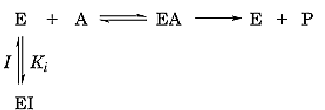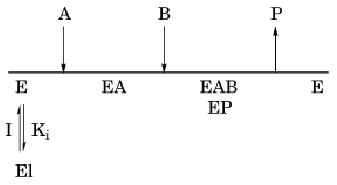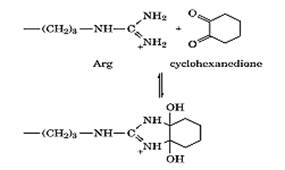


 النبات
النبات
 الحيوان
الحيوان
 الأحياء المجهرية
الأحياء المجهرية
 علم الأمراض
علم الأمراض
 التقانة الإحيائية
التقانة الإحيائية
 التقنية الحيوية المكروبية
التقنية الحيوية المكروبية
 التقنية الحياتية النانوية
التقنية الحياتية النانوية
 علم الأجنة
علم الأجنة
 الأحياء الجزيئي
الأحياء الجزيئي
 علم وظائف الأعضاء
علم وظائف الأعضاء
 الغدد
الغدد
 المضادات الحيوية
المضادات الحيوية|
Read More
Date: 20-11-2020
Date: 3-6-2021
Date: 28-11-2015
|
Competitive Inhibition
Analogues of the substrate of an enzyme can often bind at the same place within the enzyme's active site as the substrate but are not acted on by the enzyme. They are inhibitors of the enzyme, giving rise to dead-end inhibition, and they usually compete with the substrate, giving rise to competitive inhibition .
1. Linear
The simplest type of competitive inhibition occurs when an inhibitor combines reversibly at the active site of the same form of the enzyme as the substrate. The inhibitor may be a structural analogue of the substrate or a product of that substrate. In the following scheme, the inhibitor I combines reversibly with the free enzyme to form a dead-end EI complex that can only

dissociate back to the components from which it was formed. Therefore, the interaction of E and I is at thermodynamic equilibrium, and the inhibition constant Ki is a dissociation constant. The general equation that describes this type of inhibition is shown in Equation 1:

where v is the observed velocity of the reaction, V the maximum velocity, Ka the Michaelis constant for the substrate present at concentration A, I the concentration of inhibitor, and Kis the apparent inhibition constant. For a single-substrate reaction, Kis would be equal to Ki. The double-reciprocal form, Lineweaver–Burk plot, of the equation for linear competitive inhibition (Eq. 2)

indicates that a primary plot of 1/v against 1/A at different concentrations of I would yield a family of straight lines that intersect at the same point on the vertical ordinate (Fig. 1). This is the signature of competitive inhibition; sufficiently high concentrations of substrate can compete successfully with the inhibitor. The slope of each curve is given by Equation 3:

A plot of slope against inhibitor concentration would yield a straight line that intersects the abscissa at the point where I = –Kis. Since this secondary plot should be linear, the inhibition would be classified as linear competitive . Although values for Kis can be obtained by such graphical procedures, it is preferable to obtain its value by an overall fit of the primary data to the general equation by use of a least-squares fitting method (1).

Figure 1. Primary double-reciprocal plot for linear competitive inhibition.
When two substrates are involved in a reaction, the value determined directly for Kis may be only an apparent constant, with its value dependent on the concentration of the nonvaried substrate. In this case, it would also have to be stated that the inhibitor was linear
competitive with respect to a particular substrate.
Linear competitive inhibition will also be observed with a two-substrate reaction when the inhibitor is an analogue of the first substrate to add in an equilibrium ordered mechanism, A, and the second substrate to add, B, is varied (Fig. 2). The inhibition by I with respect to A will be linear competitive because both A and I compete directly for the same form of enzyme (E). The inhibition by I with respect to B will also be linear competitive, even though I and B combine with different enzyme forms, because the reaction between E and A in an equilibrium-ordered mechanism is at thermodynamic equilibrium. Thus, increasing concentrations of B will ultimately reduce the concentrations of both EA and E to zero, so that no free enzyme remains to interact with I.

Figure 2. Equilibrium-ordered mechanism for which inhibition by I would be linear competitive with respect to both substrates.
2. Hyperbolic
This type of inhibition occurs when an inhibitor binds reversibly at a site on the enzyme, other than the active site, so as to make it more difficult for the substrate to combine at the active site. Thus, the inhibitor and substrate can be present on the enzyme at the same time. The reactions involved can be illustrated as follows:

where Kis and Kid denote dissociation constants for EI and EIA, respectively. It is a thermodynamic requirement that the affinity of the substrate A for the E and EI forms differs, so that

For the inhibition to be competitive, the presence of the inhibitor on the enzyme must not affect the rate of product formation. The general equation that describes hyperbolic competitive inhibition is given in Equation 4:

which can be arranged in double-reciprocal form as

This is an equation of a straight line for a plot of 1/v against 1/A, but it is apparent that the slopes of the lines will vary as a hyperbolic function of the concentration of I and the intercept of the curves with the vertical ordinate is independent of I. For a plot of slope as a function of I, the curve would be a concave-down, nonrectangular hyperbola, with limiting values of Ka/V and KaKid/(VKis) at zero and infinite concentrations of I, respectively. Values for Kid and Kis may be obtained from a plot of 1/(slopeo – slopei against 1/I, where slopeo and slopei are slopes of the primary plot in the absence and presence of inhibitor, respectively. Values for Kis and Kid are best obtained by an overall least-squares fit of the data to the equation that describes hyperbolic competitive inhibition (1).
It should be noted that the same kinetic mechanism would apply if I were an activator that enhances the combination of the substrate with the enzyme. In this case, the plot of slope against I would yield a concave-up, nonrectangular hyperbola (2).
References
1. W. W. Cleland (1979) Meth. Enzymol. 63, 103–138.
2. V. L. Schramm and J. F. Morrison (1970) Biochemistry 9, 671–677.



|
|
|
|
تحذير من "عادة" خلال تنظيف اللسان.. خطيرة على القلب
|
|
|
|
|
|
|
دراسة علمية تحذر من علاقات حب "اصطناعية" ؟!
|
|
|
|
|
|
|
العتبة العباسية المقدسة تحذّر من خطورة الحرب الثقافية والأخلاقية التي تستهدف المجتمع الإسلاميّ
|
|
|